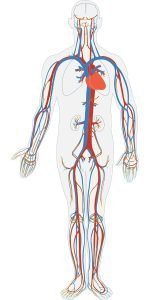Browsing: Peripheral Arterial Disease Graphics
Comprehensive Information, Resources, and Support on Peripheral Arterial Disease
Heart disease is a term that covers a range of disorders that affect the heart. Coronary artery disease is the most common type of heart disease.
One of the complications of diabetes is a heart attack. Type 1 diabetes in creases the risk for heart disease significantly. Heart attacks and other cardiovascular complications cause the death of almost 3 out of every 4 people with type 1 diabetes.
Peripheral artery disease (PAD) in the lower limbs is a highly under-diagnosed disorder which makes its diagnosis and management difficult. Atherosclerotic disease is an evident cause of PAD in limbs which leads to, both, acute or chronic symptoms such as myocardial infarction, stroke, claudication pain, etc. Lower extremity peripheral artery disease leads to complications such as critical limb ischaemia, need for limb amputation, erectile dysfunction in men, etc
The circulatory system in human body is a network of blood, blood vessels (arteries and veins), and the heart. This network supplies tissues in the body with oxygen and other nutrients that are needed by the body. The circulatory system is also called the cardiovascular system or the vascular system. Arterial disease includes any condition that affects your arteries of the circulatory system.
Peripheral artery disease (also called peripheral arterial disease) is a circulatory problem in which arteries become narrowed and blood flow is reduced to the limbs such as to legs. In particular, the extremities in the body don’t receive enough blood flow to keep up with demand.
Human heart is a wonderful organ. It beats about 60 to 100 times each minute. That’s about 100,000 times each day. It is part of the ciculatory system. Any problem with the functioning of the heart can also affect pumping of the blood to distant organs and can cause diseases associated with your ciculatory system including the peripheral vascular diseases.
Body’s lower extremity comprises of hip, thigh and leg. Hip and thigh framework includes pelvis, femur, hip joint, hip and thigh muscles, etc. Thigh extends to the knee which joins with the leg. Tibia, fibula, knee joint, knee joint muscles, etc are its main features. Leg extends to ankle and foot which comprises of bones and ligaments, ankle joint, talus, foot muscles, etc. Neurovasculature of lower limb comprises arteries, veins and nerves in this region such as femoral artery and its branches, neurovasculature of hip thigh and limb, arteries and nerves of the foot, etc. Peripheral artery disease is a common circulatory problem in limbs which causes leg weakness, numbness, difficulty in pulse detection in leg or foot, etc. The image shows peripheral runoff
Peripheral artery disease is thinning of arteries which hinder the blood blow. It can be treated with angioplasty, atherectomy and bypass surgery. Stent angioplasty reduces the blockage and widens the arteries to enhance proper blood flow. A stent or small mesh tube helps to keep the artery open. During angioplasty, a thin, flexible tube (catheter) is inserted through an artery and is guided to the narrowed portion of the artery. A small balloon at the end of the tube is inflated there and the stent is placed at the same time. Pressure created due to this presses the plaque against the wall of the artery to improve blood flow.
ADVERTISEMENT











